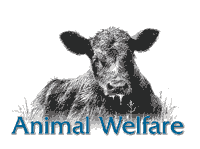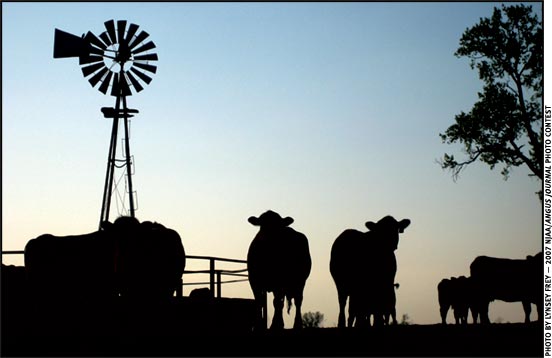Dealing with Society's
Animal Welfare Concerns
K-State's Glynn Tonsor provides an economist's take on animal welfare.
 Consumer interest in livestock production methods is growing. To a lot of livestock producers, it probably looks like society is becoming overly meddlesome. Consumers seem to think they ought to write the rules for how animals are managed. At the very least they want to make sure animal welfare concerns are addressed.
Consumer interest in livestock production methods is growing. To a lot of livestock producers, it probably looks like society is becoming overly meddlesome. Consumers seem to think they ought to write the rules for how animals are managed. At the very least they want to make sure animal welfare concerns are addressed.
In the last decade, eight states have adopted measures related to animal welfare, mostly through ballot initiatives. Gestation stalls used by the swine industry, veal calf crates and battery cages for laying hens have been the primary targets. Ohio stands out because of the agreement forged by the Human Society of the United States (HSUS) and certain state agricultural groups calling for numerous animal welfare "reforms," including the phasing out of those previously mentioned confinement housing systems. The agreement also addresses handling of downer animals and methods of euthanizing farm animals.
Kansas State University Agricultural Economist Glynn Tonsor warns that the beef industry is not immune. Tonsor says the research he and his colleagues have conducted since 2007 reveals that most consumers don't have a clear understanding of the various livestock industry segments and the different practices employed by each. Survey results suggest nearly 70% of consumers have not visited a livestock operation in the last 10 years, and 25% of consumers have never set foot on a livestock farm or ranch. The results reinforce what we thought we knew — that there is a growing disconnect between consumers and livestock production for meat, milk and eggs. Read more.

Rod Wesselman
Association Perspective
Marketing 101
Greetings from the Pacific Northwest! We have had a mild winter, and cattlemen have been able to save on some expensive hay bills. It is a double-edged sword, though, because we will need a lot of spring rains to maintain what moisture we do have.
I would like to share a friendly reminder and tips on marketing your fall feeder calves this spring, and even the calves or yearlings you will sell this summer and into the fall.
With the increase in ranch inputs today, producers need to maximize the returns on those great calves that you have produced. First, you need to start looking at marketing options early. Don't wait until the week before you want to sell your calves to see what the market is doing. Read more.
AMS Seeks Comment on Proposed Change to Act Governing Beef Checkoff
The Agricultural Marketing Service (AMS) of USDA is seeking comment on a proposed rule — published March 2, 2012, in the Federal Register — that would expand the contracting authority as established under the Beef Promotion and Research (Order). The summary of the rule published in the Federal Register states:
"The Beef Research and Information Act (Act) requires that the Beef Promotion Operating Committee (BPOC) enter into contracts with established national nonprofit industry-governed organizations, including the Federation of State Beef Councils, to implement programs of promotion, research, consumer information and industry information. The Act does not define 'national nonprofit industry-governed organization;' however, the Order states that these organizations must be governed by a board of directors representing the cattle or beef industry on a national basis and that they were active and ongoing prior to enactment of the Act. This proposed rule would change the date requirement in the Order so that organizations otherwise qualified could be eligible to contract with the BPOC for the implementation and conduct of Beef Checkoff programs if they have been active and ongoing for at least two years." Read more.
Ag Land Values Jump 31% in 2011
Nebraska's agricultural real estate values jumped 31% in the last year, the largest increase in the 34-year history of the University of Nebraska–Lincoln's (UNL) annual survey.
The 2012 UNL Nebraska Farm Real Estate Survey "confirms what most people close to agriculture already knew — agricultural land values across the state have shot upward in recent months," said Bruce Johnson, the UNL agricultural economist who conducts the survey.
Preliminary survey results show the state's all-land average value as of Feb. 1 to be at $2,410 per acre, 31% above the year-earlier level. The annual gain is a new record in both dollar amount and percentage. Read more.
ARS Nutrient Data Available via Phone Apps, Interactive Websites
Health-conscious owners of smartphones and home computers are thumbing and clicking their way to nutritious food choices. A downloadable version of the USDA flagship National Nutrient Database for Standard Reference (SR), listing more than 7,600 food items, is being downloaded and incorporated into a variety of free and for-fee consumer-oriented smartphone "apps" and interactive websites.
The SR and other nutrient databases are managed by the Agricultural Research Service (ARS) Beltsville Human Nutrition Research Center (BHNRC) in Beltsville, Md. ARS is USDA's principal intramural scientific research agency.
The BHNRC Nutrient Data Laboratory, headed by nutritionist Joanne Holden, provides free electronic access to SR in a variety of formats online from its website. There are hundreds of free and for-fee apps for iPhone, iPod Touch, Android, Windows Phone 7 and BlackBerry® handheld devices. Many of these apps are related to nutrition and health, and are based on the download and import of BHNRC national nutrient databases. Read more.
What’s Inside …
In this March edition of the Angus Beef Bulletin EXTRA, you'll find valuable articles devoted to the management, marketing, and health and nutrition of your beef enterprise. Select from the tabs at the top of the page to access this month's entire offering by category. A few select features include:
- Feeding Flavor
- Facing a Growing Fly Problem
- Controlling the Controllable
- Scientists Move Closer to Solving Pasture Bloat Problem
- Rapid Detection
- The Source: ASCC winds up four-year demo
- Cattle Outlook
News Briefs …
The American Angus Association and its subsidiaries generate a wealth of information to keep members and affiliates informed of what's happening within the industry as well as with the programs and services they offer. Click here for easy access to the newsrooms of the American Angus Association and Certified Angus Beef LLC and the Angus e-List archive.
NFU Outlines What It Calls a Less Expensive,
More Effective Farm Bill Plan
National Farmers Union (NFU) President Roger Johnson testified before the U.S. Senate Committee on Agriculture, Nutrition and Forestry to discuss risk management and commodities in the 2012 Farm Bill.
"Every family farmer, rancher and consumer benefits from a strong and effective safety net for commodities," said Johnson. "Commodity prices do not remain high and do not always return a profit to our producers. When prices fall, and we know they will, it is critical that a price-based safety net be in place, because we know that long-lasting drops in commodity prices and artificially high price peaks are harmful to the entire production supply chain, in both domestic and international markets." Read more.
UC Davis Scientists Discover Likely Trigger for Metabolic Syndrome
A likely suspect found for epidemic of metabolic syndrome, a risk factor for diabetes and cardiovascular disease.
University of California–Davis (UC Davis) scientists have uncovered a key suspect in the destructive inflammation that underlies heart disease and diabetes. The new research shows elevated levels of a receptor present on leucocytes of the innate immune response in people at risk for these chronic diseases. The receptors are the body's first line of defense against infectious invaders, and they trigger a rush of cytokines, the body's aggressive immune soldiers, into the bloodstream. Read more.
[Click here to go to the top of the page.]













